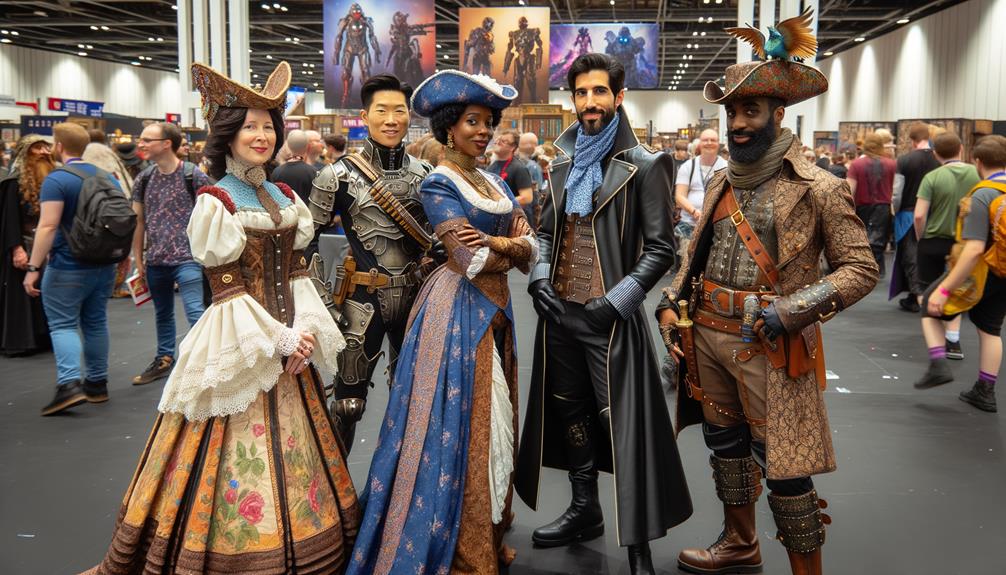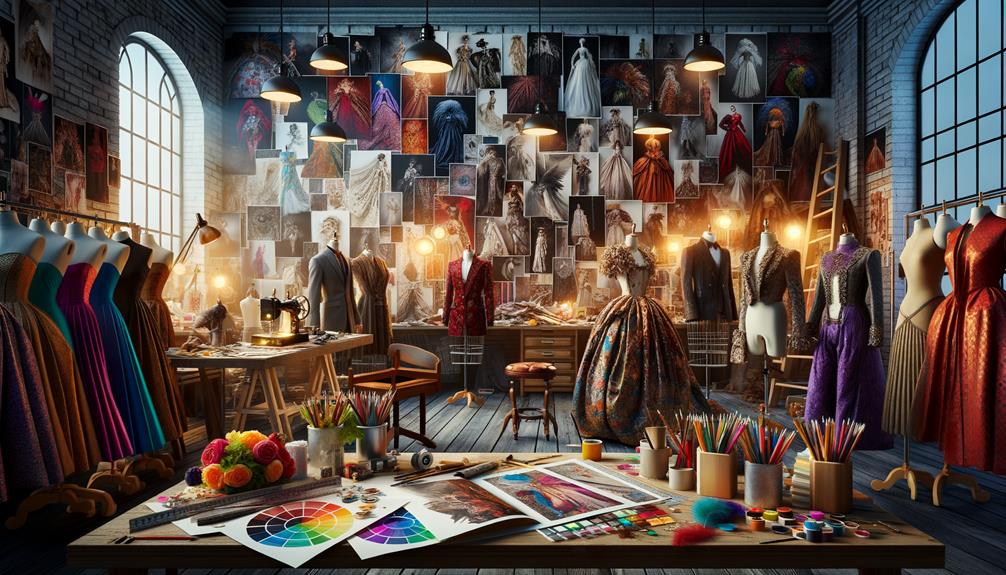Costume design has long fascinated me, tracing its roots to ancient Greek festivals honoring the god Dionysus. Greek innovations like masks, which amplified voices and captured characters' essence, laid a timeless foundation. The Renaissance brought opulence and historical homage, weaving grandeur into Shakespeare's plays. The 18th and 19th centuries saw fabric innovations and a pursuit of historical accuracy, making performances more authentic. Art Deco's geometric patterns and bold colors transformed theater into a spectacle of modernity and luxury. Today, digital advancements allow creative possibilities that push the boundaries of what we can achieve on stage. Each era tells a story, with so much more to discover.
Early Beginnings
Reflecting on humanity's creative journey, it's fascinating to see how ancient Greek festivals honoring the god Dionysus laid the groundwork for costume design in theatrical performances. These festivals, filled with the spirit of wine and revelry, were more than just celebrations; they were the crucible where theatre as we know it was forged.
The ancient Greeks, with their flair for drama, began to use elaborate masks and costumes to bring their stories to life. Imagine the vibrant scenes where Greek playwrights like Aeschylus, Sophocles, and Euripides showcased their works. The actors, dressed in lifelike costumes, transformed into gods, heroes, and mythical creatures, creating a visual spectacle that captivated audiences.
The ancient Greek emphasis on elaborate masks wasn't just for show. These masks, often exaggerated in expression, served a dual purpose: they amplified the actor's voice and conveyed the emotional essence of the character to the audience seated far away in vast amphitheaters. It's clear that the roots of costume design are deeply intertwined with the innovative spirit of ancient Greece. Their legacy continues to inspire and remind us of the power of creativity and its ability to transcend time.
Renaissance Influence
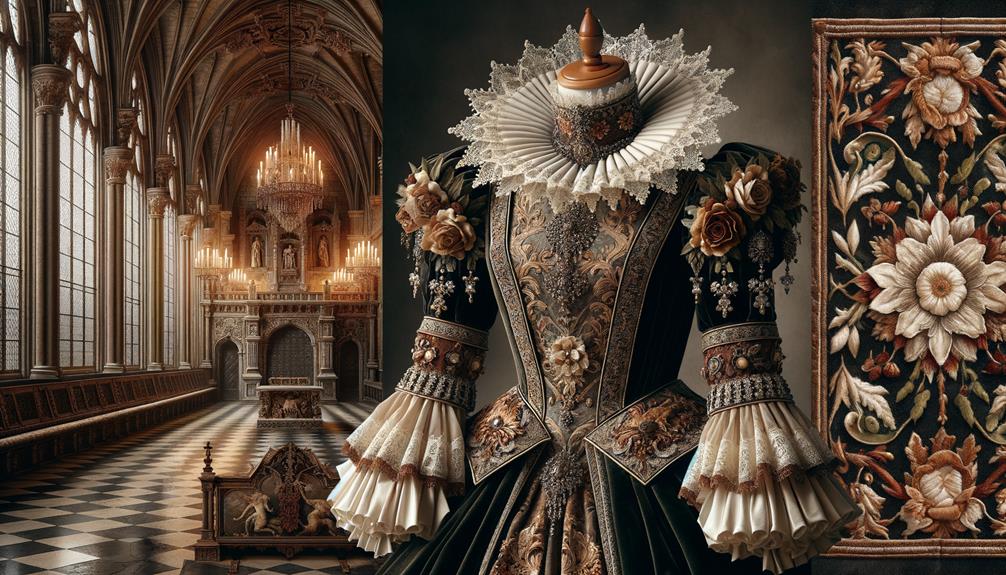
The Renaissance period was a transformative era for stage costumes, blending classical antiquity and burgeoning European fashion. It's fascinating to see how this era borrowed from Greek traditions, yet reinvented them with a distinct Renaissance flair. For example, Shakespeare's plays often featured actors in Roman togas, nodding to ancient styles while seamlessly incorporating the rich textures and vibrant colors of Elizabethan England.
Three key elements stand out when considering the innovation of this period:
- Classical Inspiration: Costumes drew heavily from ancient Greek and Roman attire, reflecting a reverence for classical antiquity.
- Lavish Details: The opulence seen in Shakespeare's plays, with costumes often borrowed from nobility, added a layer of authenticity and grandeur.
- Distinct Archetypes: Commedia dell'arte troupes used iconic, easily recognizable costumes to define their characters, which became a hallmark of the genre.
This Renaissance influence wasn't just about appearance; it was a blend of historical homage and contemporary innovation. It offered a vivid, dynamic backdrop that enhanced storytelling, making characters larger-than-life and performances unforgettable.
18th-19th Century Changes
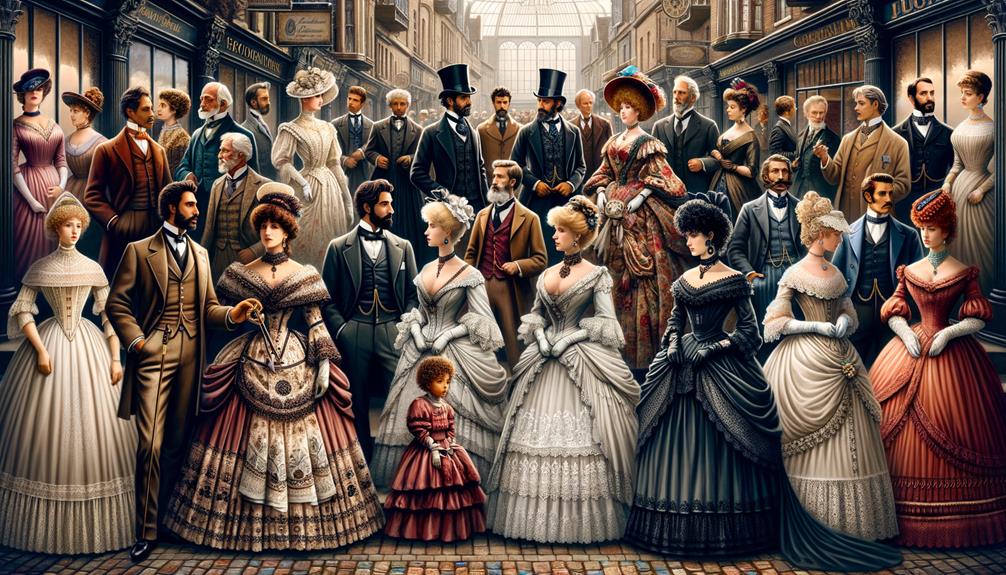
The 19th century saw remarkable advancements in fabric innovations and costume design techniques. Royalty's influence was evident, as trends they set trickled down to the stage, where Romanticism began to flourish. This shift wasn't just aesthetic; it brought a newfound practicality and historical accuracy that transformed the way actors connected with their roles.
Fabric and costume innovations revolutionized the theatrical experience during this period. The aristocracy's fashion choices became widely emulated, inspiring costume designers to create more authentic and relatable attire for performers. This shift toward realism and historical accuracy allowed actors to better embody their characters, enhancing the audience's connection to the on-stage story.
Fabric Innovations and Techniques
Through the lens of the 19th century, I'm amazed at how synthetic dyes and advanced weaving techniques transformed costume design. These innovations allowed for a vibrant and intricate array of textiles that were previously unimaginable. Designers could now work with a broader palette of colors thanks to synthetic dyes, which were introduced in the mid-1800s. This enabled the creation of visually stunning garments that captivated audiences.
New weaving techniques, like the jacquard loom, also added complexity to costume fabrics. These methods allowed for the production of intricate patterns and textures, elevating the richness of the costumes. Additionally, the increased availability of machine-sewn and mass-produced textiles made high-quality fabrics more accessible and affordable for theater companies.
Here are three key advancements that shaped costume design during this period:
- Synthetic dyes: Expanded the range of colors available to designers.
- Jacquard looms: Enabled the creation of complex textile patterns.
- Mass production: Made high-quality fabrics more accessible and affordable.
These innovations laid the groundwork for the vibrant and diverse world of costume design we know today.
Influence of Royalty
It's fascinating to see how the whims of European royalty in the 18th and 19th centuries shaped the opulence and extravagance of theater costumes, defining a whole era of design. Aristocratic patrons, with their penchant for lavishness, would often lend their elaborate garments to actors, creating a trend that emphasized grandeur on stage. This practice not only enhanced the visual appeal but also set a standard of luxury that resonated through the theater world.
This influence led to the emergence of historically accurate costume designs. The desire to faithfully depict specific time periods, such as the Elizabethan era, transformed the art of costume design. Designers began to pay meticulous attention to historical details, ensuring that the costumes worn by actors reflected the aesthetics of the time they were portraying.
Another notable shift was the experimentation with Neoclassical aesthetics. Incorporating elements of Greek and Roman styles, designers infused a sense of antiquity and elegance into their creations. This period marked a move towards realism and authenticity, steering productions away from impractical extravagance and towards visually and historically coherent representations.
The impact of royalty on costume design during these centuries was significant; it was a catalyst for innovation and authenticity in theatrical productions.
Shift to Romanticism
The grand displays of European royalty began to fade as a new appreciation for simpler, more functional designs took hold in the 19th century. Costume designers started focusing on historically accurate costumes, allowing actors to fully immerse themselves in their roles. This shift transformed the entire theatrical experience.
Charles Kean's productions of Shakespearean plays marked a turning point. By emphasizing historically accurate costumes, he put the performance at the forefront, resonating with audiences seeking authenticity.
The introduction of electric lighting in theaters opened up new avenues for costume designers:
- Expanded color palettes: Electric lighting enabled a wider range of colors previously unattainable.
- Textural experimentation: Designers could now play with fabrics and textures that reacted beautifully under the new lighting.
- Actor collaboration: Actors became more involved in the design process, ensuring their costumes felt true to their characters.
The collaboration between actors and costume designers transformed theater, making it a more immersive and believable experience for audiences. This period marked a significant evolution in the art of costume design.
Art Deco Era
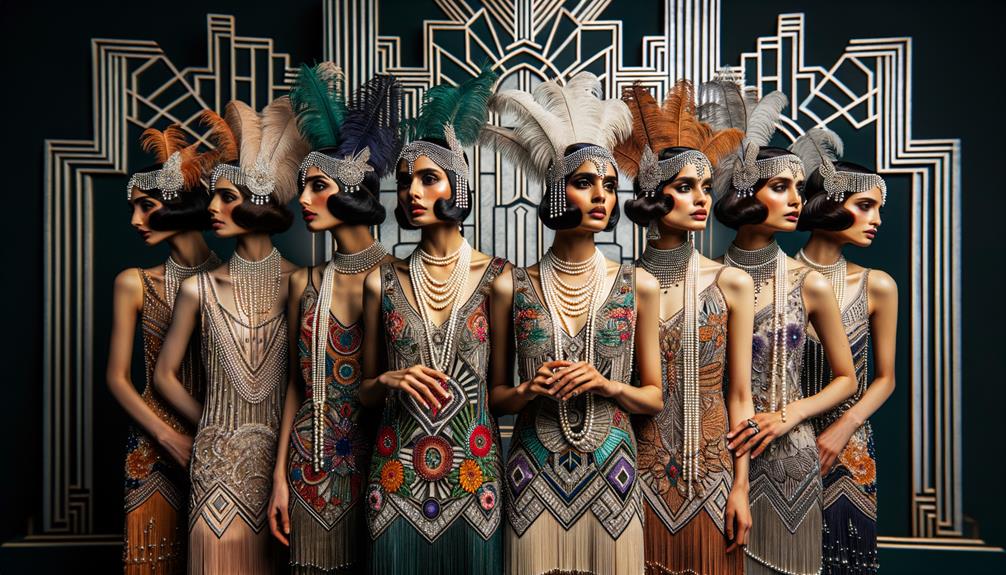
The Art Deco era captivated me with its geometric patterns that defined its essence. Luxurious materials and bold color schemes conveyed a sense of opulence and modernity, profoundly influencing the theatrical world. Erte's work, in particular, epitomized this blend of elegance and innovation, forever altering costume design.
Geometric Patterns Dominance
Amid the vibrant backdrop of the 1920s, I'm struck by how Erte's use of sharp angles and bold colors encapsulated the geometric patterns that dominated the Art Deco era. Designing costumes for the Folies Bergère and Ziegfeld Follies, Erte's creations became iconic for their sophisticated blend of classical elegance and geometric abstraction. His work went beyond simply clothing performers; it was a visual statement that resonated with the modernist, machine-inspired aesthetics of the time.
Observing Erte's costumes, a few defining features stand out:
- Sharp Angles and Symmetry: These elements created a dynamic visual impact, emphasizing the sleek sophistication of the era.
- Bold Colors: The use of vivid hues added a layer of intensity and drama, making the characters unforgettable.
- Stylized Floral Motifs: These designs married nature with geometry, reflecting the Art Deco movement's innovative spirit.
Erte's influence is undeniable. His ability to merge modernist aesthetics with theatrical flair transformed how costumes were perceived. They weren't just outfits; they were art pieces that brought characters to life, each stitch a chronicle to the era's relentless pursuit of innovation.
Luxurious Materials Usage
Reflecting on the lavishness of the Art Deco era, I'm struck by how designers like Erte masterfully used opulent materials like silk, velvet, and metallic fabrics to create costumes that were true theatrical masterpieces. The costumes of that period weren't just about fashion – they were statements, evoking an aura of unparalleled glamour and sophistication.
Erte's designs, especially for the Folies Bergère in Paris and the Ziegfeld Follies in New York, showcased an incredible blend of sumptuous materials and dramatic flair. The intricate beading, feathers, and sequins on these period costumes added a layer of spectacle and grandeur that was mesmerizing. I often wonder what it must have felt like to wear costumes so rich in texture, weight, and visual impact.
The luxurious fabrics didn't just serve as eye candy; they also underscored the elegance and decadence that defined the Art Deco aesthetic. The era's attention to material detail has influenced countless contemporary costume designers seeking to capture that same sense of bygone elegance. The innovative use of such opulent materials continues to inspire, reminding us of a time when fashion and art were truly intertwined.
Bold Color Schemes
Diving into the bold color schemes of the Art Deco era, I'm captivated by how designers like Erte used vibrant hues and geometric patterns to transform costumes into visual masterpieces that still resonate today. The distinct flair of the 1920s and 1930s saw an explosion of creativity, where every color and line was carefully chosen to evoke the essence of the characters and the opulence of the period.
Erte's work for the Folies Bergère and Ziegfeld Follies exemplifies this. His daring use of striking colors like bold reds, yellows, and blues, combined with angular lines and streamlined shapes, created a spectacle that was both sophisticated and innovative. These costumes weren't just clothing; they were statements of artistic prowess.
To better understand the impact of these designs, consider:
- Vivid Color Palettes: The use of bright primary colors was revolutionary, making every character pop on stage.
- Geometric Patterns: Angular designs gave a sense of modernity and movement, perfectly encapsulating the era's spirit.
- Dramatic Silhouettes: The emphasis on bold shapes and lines made the costumes look like moving art pieces.
The Art Deco era's influence is still evident in modern productions, where designers continue to draw from its innovative spirit to create visually stunning costumes.
Modern Innovations
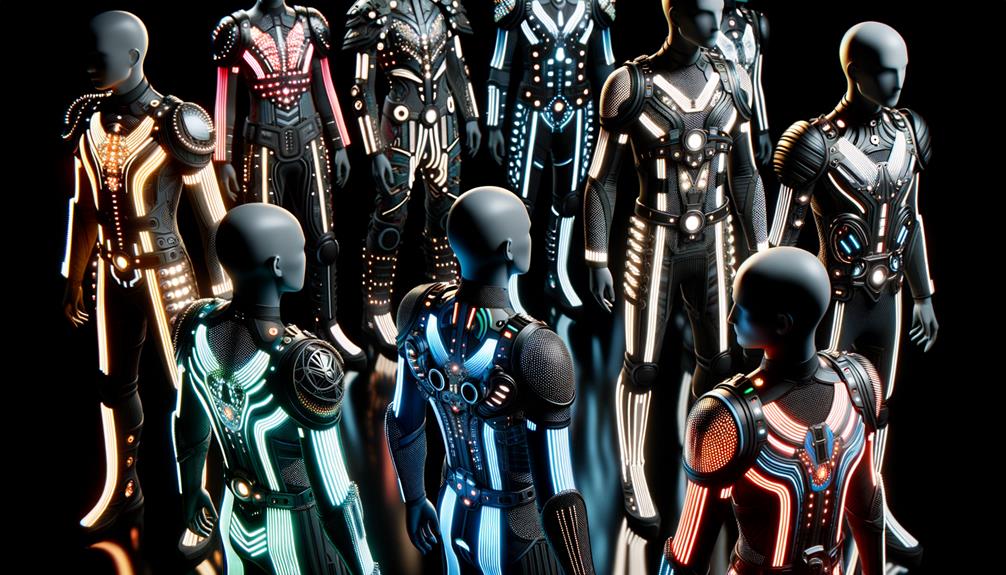
The world of costume design has undergone a remarkable transformation thanks to innovative technologies. Computer-aided design software has revolutionized the way costumes are created, allowing designers to experiment with fabrics, colors, and silhouettes digitally before committing to production. This has not only streamlined the process but also sparked a surge of creativity, offering endless possibilities.
3D printing has become a game-changer in the industry, enabling the creation of intricate costume pieces and accessories that were previously challenging or costly to manufacture. From futuristic armor to fantastical headpieces, the precision and detail achieved with 3D printing are truly astounding.
Motion capture technology has also transformed the approach to costume design for film and video game characters. Ensuring a seamless integration between the actor's movements and the character's attire has never been more accurate. This technology allows designers to create costumes that move naturally with the actor, enhancing the believability and immersion of the character.
These advancements have collectively pushed the boundaries of what's achievable in costume design, opening up new possibilities for designers to explore.
Cultural Impact
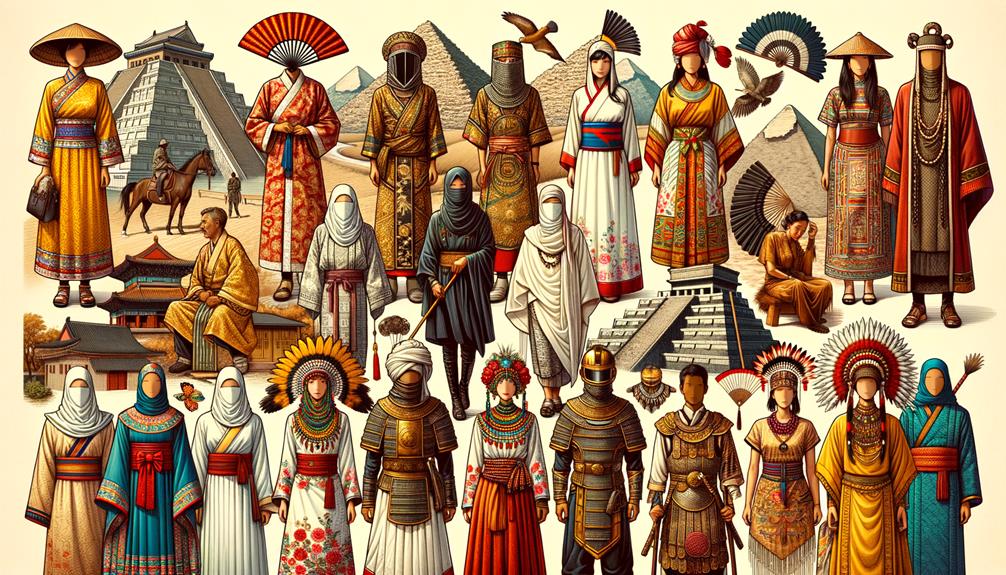
Costume design has become deeply ingrained in popular culture, transforming everyday fabrics into iconic symbols and enduring fashion statements. From the intricately crafted costumes of medieval theatre to the grandeur of Elizabethan stage productions, these designs have defined the essence of characters, lending authenticity and flair to actors' performances.
The influence of costume design extends far beyond the stage or screen. A few key examples illustrate its profound impact:
- Memorable Film and Theatre Looks: Audrey Hepburn's little black dress in 'Breakfast at Tiffany's' or the ornate gowns of Elizabethan theatre have transcended their original mediums, becoming influential fashion statements in their own right.
- Enduring Cultural Icons: Collaborations between costume designers and performers have created lasting legacies, like Edith Head's work transforming stars into timeless icons that left a lasting imprint on popular culture.
- Period Accuracy: Meticulous attention to historical detail in costume design immerses audiences in different eras, making period narratives more vivid and engaging.
These examples underscore the profound influence of costume design. By blending artistic expression with historical context, designers don't merely clothe actors; they transport audiences into worlds where fabric tells a captivating story.
Frequently Asked Questions
What Is the Origin of Costume Design?
The origins of costume design trace back to ancient rituals and performances. It's fascinating to see how early humans used attire to convey identity, tell stories, and evoke emotion – sparking endless innovation in theatrical presentation. Costume design has long been an integral part of human culture, evolving alongside our artistic expressions and social customs. From ceremonial garments to theatrical costumes, the interplay between dress and performance has captivated audiences for millennia. As we delve into the rich history of this creative field, we uncover the deep roots that continue to shape the art of costume design today.
What Is the History of Costumes?
The history of costumes is a rich tapestry spanning centuries. In ancient Greece, masks were essential for theatrical performances, while the Renaissance era saw the rise of lavish, ornate attire. The Elizabethan period then ushered in a distinct fashion trend. The 19th century brought a focus on realism, while the 20th century transformed visual storytelling through innovative costume design. From the dramatic masks of the past to the ever-evolving styles of today, the history of costumes reflects the changing cultural and artistic landscapes over time.
What Are the 6 Elements of Costume Design?
When I think about costume design, I picture vibrant colors, graceful silhouettes, rich textures, intricate patterns, dynamic lines, and the way movement brings the character to life. Each of these elements is critical in crafting the essence of the character on screen or on stage.
The choice of color can instantly communicate a character's mood, personality, or social standing. Flowing silhouettes evoke a sense of elegance and movement, while textured fabrics add depth and realism. Intricate patterns can reflect cultural influences or a character's background. Dynamic lines create a sense of energy and purpose. And the way the costume moves with the actor's performance breathes life into the character.
Together, these six elements – color, silhouette, fabric, pattern, line, and movement – form the foundation of costume design. Each one is a powerful tool that the costume designer uses to visually define and enhance the character.
What Is the Order of the Costume Design Process?
When designing costumes, I first read the script to understand the characters and their journeys. Then, I meet with the director to discuss their vision. From there, I create rough sketches, refine them based on the director's feedback, and develop detailed drawings. Finally, I send these drawings to the costume shop to begin the construction process. Throughout, I keep a costume plot to stay organized and ensure everything comes together seamlessly.
Conclusion
From the intricate tapestries of the Renaissance to the sleek lines of Art Deco, each era's unique flair has left an indelible mark on costume design. Observing today's innovations, I'm amazed by the blend of tradition and technology shaping our cultural expressions. The global costume design industry is projected to reach $6.3 billion by 2026, showcasing the industry's impressive growth. As we look back, we can see how far the field has come, with costume designers continuously pushing the boundaries of their craft.



